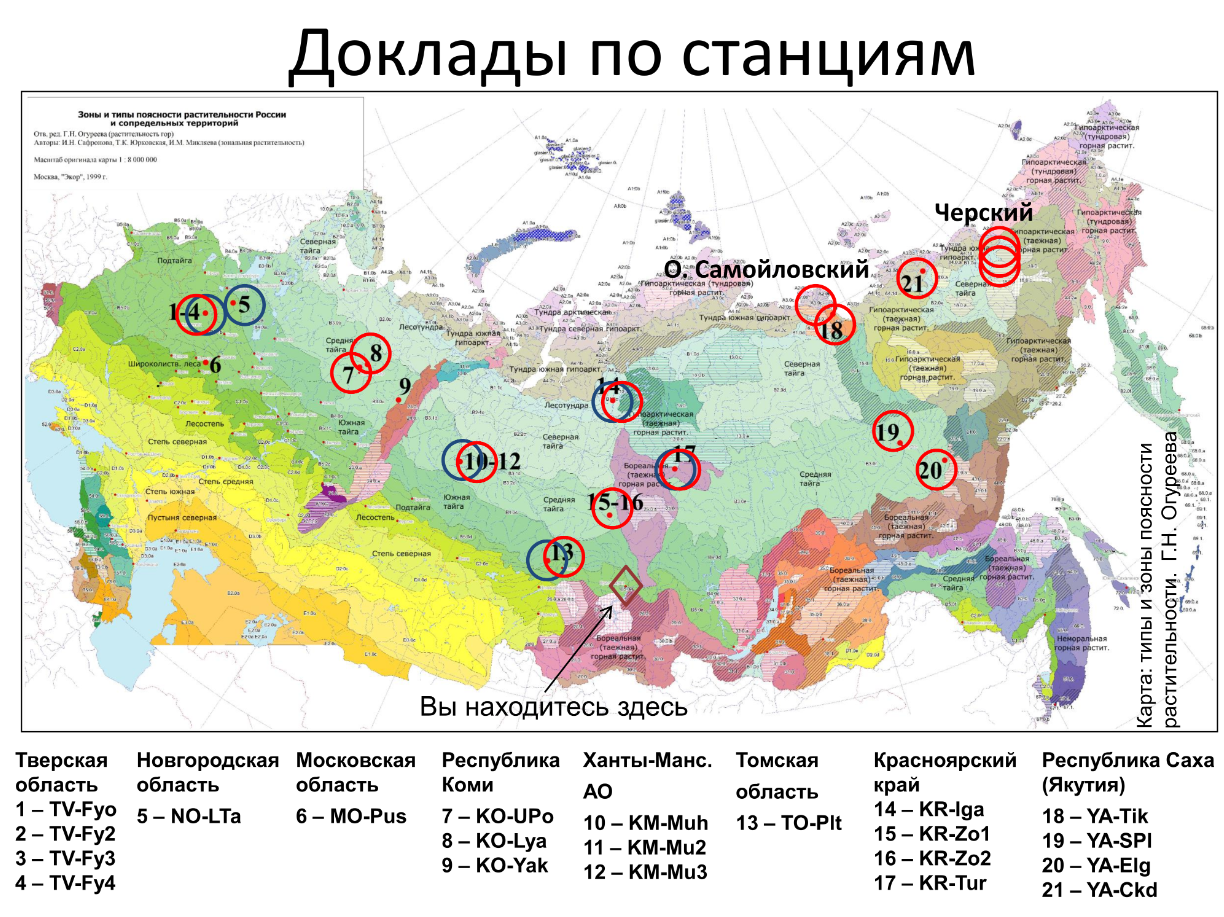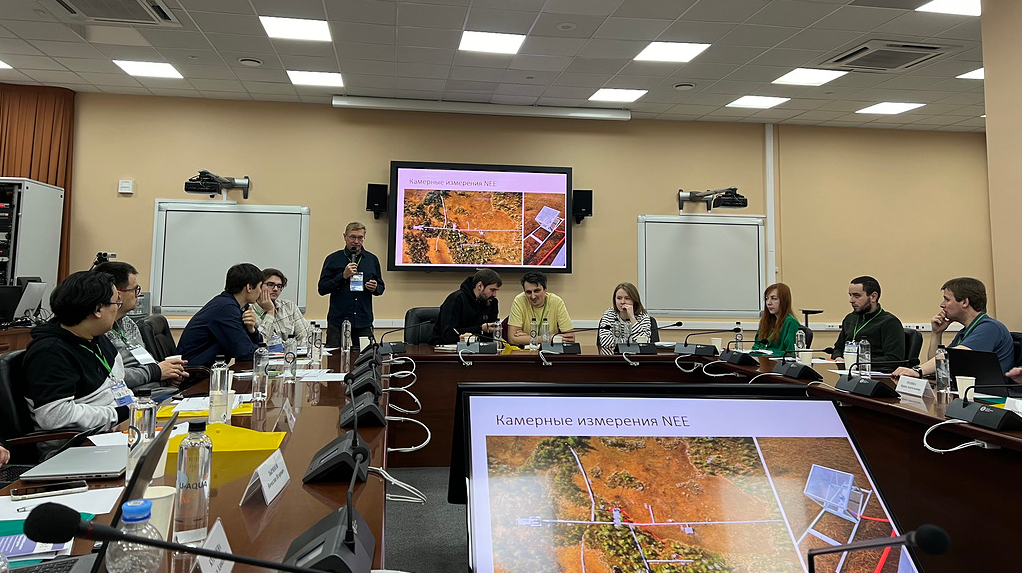At the Siberian Federal University in Krasnoyarsk, on November 27-29, 2023, the II meeting of the Working Group on Data Processing for Assessing Ecosystem Fluxes of Greenhouse Gases was held. More than twenty researchers from all over the country took part in the meeting. Most of the meeting participants work within the framework of the 4th consortium of the Russian Climate Monitoring System, the most important innovative project of national importance.
The meeting was organized by the V.N. Sukachev Forest Institute SB RAS, REC "Yenisei Siberia" (Krasnoyarsk) and Siberian Federal University (Krasnoyarsk), as well as the A.N. Severtsov Institute of Ecology and Evolution RAS (Moscow). The meeting was opened by the director of the project office of the Yenisei Siberia Research Center Sergei Verkhovets, the Siberian Federal University vice-rector for scientific work Ruslan Baryshev, and the director of the SFU Institute of Fundamental Biology and Biotechnology Vladimir Shishov.
The scientific director of Siberian Federal University, Academician of the Russian Academy of Sciences, Doctor of Biological Sciences Evgeny Vaganov addressed the participants with inspiring and warm opening words.Siberian Federal University provided a conveniently equipped auditorium and solutions to technical and organizational issues during the meeting of the Working Group.
In addition to teams from the organizers, employees of the following scientific institutions participated: Yugra State University (Khanty-Mansiysk), Institute of Biology of the Komi Scientific Center of the Ural Branch of the Russian Academy of Sciences (Syktyvkar), Institute of Biological Problems of the Cryolithozone SB RAS (Yakutsk), A.M. Obukhov Institute of Atmospheric Physics RAS (Moscow), Institute for Monitoring of Climatic and Ecological Systems SB RAS (Tomsk), National Research Tomsk State University (Tomsk), Federal Scientific Center for Agroecology RAS (Volgograd), North-Eastern Scientific Station (Chersky). The meeting sections were moderated by Ph.D. Anatoly Prokushkin (IL), Ph.D. Yulia Kurbatova and Ph.D. Olga Kuricheva (IPEE RAS), Ph.D. Egor Dyukarev (IMKES). On the first day, researchers from different teams talked about the features of data processing at the environmental and climatic stations that they supervise.

The map shows the stations that the participants talked about: at the 1st meeting of the Working Group on 04/2–4/2023 (in blue) and at the 2nd meeting on 11/27–29/2023 (in red).
One cannot but be pleased with the expansion of the number of participants in the Second Meeting relative to the First Meeting, held in April of this year. At the II meeting, reports were made on the longest operating stations in Russia, the history of observations at which goes back more than 20 years. These are the Fedorovskoye station in the Central Forest Reserve in the Tver region, belonging to the South Valdai Ecological Observatory “Okovsky Forest” (report by Andrey Varlagin, Ph.D., IEE RAS) and the international station Spasskaya Pad in central Yakutia, the SakhaFluxNet network (report to Biological Sciences Roman Petrov, IBPK SB RAS). The results of measurements on a network of stations in the Komi Republic were introduced to the listeners by Ph.D. Mikhail Miglovets and Doctor of Biological Sciences Svetlana Zagirova (IB Ural Branch RAS). The report by Nikita Zimov (North-Eastern Scientific Station) was devoted to measurements of greenhouse gas flows at a network of stations in the Pleistocene Park near the village Chersky, where a unique natural and climatic experiment is being conducted to create a highly productive pasture Arctic ecosystem. Doctor of Physical and Mathematical Sciences, Prof. of RAS Irina Repina (IAP RAS) spoke about the measuring systems and features of the data at two remote tundra stations in Yakutia, as well as about the dependence of flows on the height of measurements. Ph.D. Vyacheslav Zyryanov (IL SB RAS) made a report on the northern stations of the Krasnoyarsk Territory (KrasFlux network) and on a new mobile complex for measuring turbulent flows. Ph.D. Egor Dyukarev (IMKES SB RAS) summarized the ideas for data filtering that arose at the first meeting of the working group, applying different stages of filtering to data for the Khanty-Mansi Autonomous Okrug and the Tomsk region. Ph.D. Olga Kuricheva (IPEE RAS) summarized the international experience of pulsation observation networks. Special mention goes to the representatives of youth laboratories Dmitry Trusov (IL SB RAS) and Elizaveta Satosina (IPEE RAS), who spoke on the second day of the meeting with reports and messages that initiated lively discussions.
On the second day, workshops were held on filling in gaps using a script written in Python (Evgeniy Kurbatov and Vadim Mamkin, Institute of Ecology and Evolution of the Russian Academy of Sciences) and on building a footprint using a script written in R (Anna Terskaya, Lund University, Sweden).

Participants noted that a working meeting is a very productive format for scientific communication, allowing them to receive positive feedback on their work from competent colleagues and to incorporate new methods into their work. The reports sometimes developed into lively discussions about the operation of the equipment, the features of using the turbulent pulsation method, and the features of data calculation and analysis. The workshops allowed participants to try new methods, while collegial solutions to emerging problems were very convenient.
It is planned to continue meetings of the Working Group in 2024.
